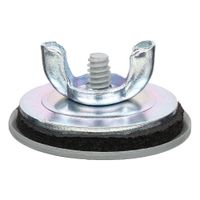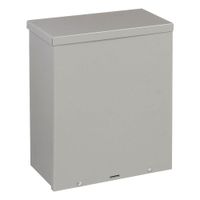Call +(254) 703 030 000 / 751 483 999 / 721 704 777
- Home
- Electrical
- Electrical Boxes Enclosures
- Electrical Enclosures Accessories
.....Read More
Frequently Asked Questions
What are the types of electrical enclosures?
Electrical enclosures are protective cases designed to house electrical components, safeguarding them from environmental factors and ensuring safety. The types of electrical enclosures are categorized based on their material, design, and protection level:
1. **Material-Based Types:**
- **Metal Enclosures:** Made from steel, stainless steel, or aluminum, these offer robust protection against impact and are often used in industrial settings.
- **Plastic Enclosures:** Typically made from polycarbonate or ABS, these are lightweight and corrosion-resistant, suitable for indoor and outdoor use.
- **Fiberglass Enclosures:** Known for their durability and resistance to chemicals, they are ideal for harsh environments.
2. **Design-Based Types:**
- **Wall-Mounted Enclosures:** Installed on walls, these are used for housing smaller electrical components.
- **Floor-Mounted Enclosures:** Larger enclosures that rest on the floor, suitable for housing bigger equipment.
- **Junction Boxes:** Small enclosures used to protect wire connections.
3. **Protection Level-Based Types (NEMA and IP Ratings):**
- **NEMA Enclosures:** Rated by the National Electrical Manufacturers Association, these enclosures are categorized from NEMA 1 (basic protection) to NEMA 13 (protection against dust, water, and oil).
- **IP Rated Enclosures:** Defined by the International Electrotechnical Commission, these ratings indicate protection against solids and liquids, such as IP65 (dust-tight and protected against water jets).
4. **Specialized Enclosures:**
- **Explosion-Proof Enclosures:** Designed to contain any explosion originating within the enclosure, preventing ignition of the surrounding atmosphere.
- **Weatherproof Enclosures:** Built to withstand outdoor conditions, protecting against rain, snow, and UV radiation.
These enclosures are selected based on the specific requirements of the application, considering factors like environmental conditions, size, and the level of protection needed.
How do I choose the right size for an electrical enclosure?
To choose the right size for an electrical enclosure, follow these steps:
1. **Component Inventory**: List all components to be housed, including circuit breakers, switches, relays, and wiring. Consider future expansion needs.
2. **Space Calculation**: Measure the dimensions of each component. Add extra space for wiring, heat dissipation, and maintenance access. A general rule is to add 20-30% more space than the components require.
3. **Environmental Considerations**: Determine the enclosure's location. For outdoor or harsh environments, ensure the enclosure is larger to accommodate additional protective features like insulation or cooling systems.
4. **Thermal Management**: Calculate heat dissipation needs. Larger enclosures may be necessary to accommodate fans, vents, or air conditioning units to prevent overheating.
5. **Regulatory Compliance**: Check industry standards and regulations (e.g., NEMA, IP ratings) that may dictate minimum size requirements based on environmental exposure and safety.
6. **Accessibility and Maintenance**: Ensure the enclosure is large enough for easy access to components for maintenance and troubleshooting. Consider door size and opening angles.
7. **Mounting and Installation**: Consider the space required for mounting brackets, panels, and any additional equipment like transformers or power supplies.
8. **Aesthetic and Space Constraints**: Ensure the enclosure fits within the designated space without obstructing other equipment or pathways.
9. **Budget Considerations**: Larger enclosures are more expensive. Balance size with cost-effectiveness while ensuring all functional requirements are met.
10. **Consultation**: If unsure, consult with an electrical engineer or enclosure manufacturer for recommendations based on specific needs and constraints.
What materials are used for electrical enclosures?
Electrical enclosures are made from a variety of materials, each chosen for specific properties that suit different applications and environments. Common materials include:
1. **Steel**: Often used for its strength and durability, steel enclosures are typically coated with a layer of paint or powder to prevent corrosion. They are suitable for indoor and outdoor applications where impact resistance is important.
2. **Stainless Steel**: Known for its corrosion resistance, stainless steel is ideal for harsh environments, including marine and industrial settings. It is more expensive than regular steel but offers superior longevity and resistance to chemicals.
3. **Aluminum**: Lightweight and corrosion-resistant, aluminum enclosures are used in applications where weight is a concern. They offer good thermal conductivity and are often used in electronics to dissipate heat.
4. **Plastic**: Enclosures made from plastics like polycarbonate, ABS, or fiberglass-reinforced polyester are lightweight, non-conductive, and resistant to corrosion. They are suitable for indoor and outdoor use, especially in environments where electrical insulation is critical.
5. **Fiberglass**: Known for its high strength-to-weight ratio, fiberglass enclosures are resistant to chemicals and UV radiation. They are often used in outdoor applications and in industries like telecommunications and utilities.
6. **Polycarbonate**: This thermoplastic is impact-resistant and can withstand extreme temperatures. It is often used for transparent enclosures or where visibility of internal components is necessary.
7. **ABS (Acrylonitrile Butadiene Styrene)**: A cost-effective plastic option, ABS is used for indoor applications where impact resistance and toughness are required.
Each material offers distinct advantages and is selected based on factors like environmental conditions, mechanical requirements, and cost considerations.
How do I ensure proper ventilation in an electrical enclosure?
To ensure proper ventilation in an electrical enclosure, follow these steps:
1. **Assess Heat Load**: Calculate the total heat generated by the components inside the enclosure. This includes the power dissipation of all electrical devices.
2. **Select Appropriate Enclosure**: Choose an enclosure with adequate space to allow for airflow. Consider materials that dissipate heat effectively, such as metal.
3. **Install Ventilation Openings**: Design the enclosure with strategically placed vents. Ensure that the size and number of vents are sufficient to allow for natural convection.
4. **Use Fans or Blowers**: If natural ventilation is insufficient, install fans or blowers to enhance airflow. Position them to create a consistent flow of air across all components.
5. **Implement Heat Exchangers**: For enclosures in harsh environments, use heat exchangers to transfer heat from inside to outside without exposing internal components to external contaminants.
6. **Consider Air Conditioning Units**: In cases of high heat loads or sensitive equipment, install air conditioning units specifically designed for electrical enclosures.
7. **Monitor Temperature**: Use temperature sensors to continuously monitor the internal temperature. Set up alarms to alert if temperatures exceed safe levels.
8. **Regular Maintenance**: Clean and inspect vents, fans, and filters regularly to prevent dust accumulation, which can impede airflow.
9. **Seal Properly**: Ensure that all seals and gaskets are intact to prevent ingress of dust and moisture, which can affect both ventilation and component integrity.
10. **Follow Standards**: Adhere to relevant industry standards and guidelines, such as those from the National Electrical Manufacturers Association (NEMA) or the International Electrotechnical Commission (IEC), for enclosure design and ventilation.
By implementing these strategies, you can maintain optimal operating conditions and prolong the lifespan of the electrical components within the enclosure.
What are the IP and NEMA ratings for electrical enclosures?
IP (Ingress Protection) ratings are defined by the International Electrotechnical Commission (IEC) to specify the degree of protection provided by electrical enclosures against solids and liquids. The IP rating consists of two digits: the first digit (0-6) indicates protection against solid objects and dust, while the second digit (0-9) indicates protection against water. For example, an IP67 rating means the enclosure is dust-tight and can withstand immersion in water up to 1 meter for 30 minutes.
NEMA (National Electrical Manufacturers Association) ratings are used primarily in North America to define the types of environments in which an electrical enclosure can be used. NEMA ratings cover protection against environmental hazards such as dust, water, oil, and corrosive materials. They also consider construction features like corrosion resistance and gasket sealing. Common NEMA ratings include:
- NEMA 1: Indoor use, basic protection against dust and light.
- NEMA 3R: Outdoor use, protection against rain and sleet.
- NEMA 4: Indoor or outdoor use, protection against windblown dust and rain, hose-directed water, and ice formation.
- NEMA 4X: Similar to NEMA 4, with added corrosion resistance.
- NEMA 6P: Submersible for prolonged periods, with added corrosion resistance.
While both IP and NEMA ratings provide information on the protective qualities of enclosures, they are not directly interchangeable. IP ratings focus on ingress protection, while NEMA ratings encompass a broader range of environmental factors.
How can I protect electrical enclosures from extreme temperatures?
To protect electrical enclosures from extreme temperatures, consider the following strategies:
1. **Insulation**: Use thermal insulation materials to reduce heat transfer. Insulation can help maintain a stable internal temperature by minimizing the impact of external temperature fluctuations.
2. **Cooling Systems**: Install air conditioners, heat exchangers, or thermoelectric coolers to actively manage the temperature inside the enclosure. These systems can remove excess heat generated by the equipment or from the external environment.
3. **Heating Elements**: In cold environments, use heaters or heat pads to prevent the internal temperature from dropping too low, which can cause condensation and damage to sensitive components.
4. **Ventilation**: Ensure proper ventilation by using fans or vents to facilitate air circulation. This can help dissipate heat and prevent overheating.
5. **Reflective Coatings**: Apply reflective or light-colored coatings to the exterior of the enclosure to reflect sunlight and reduce heat absorption.
6. **Location**: Position the enclosure in a shaded or sheltered area to minimize exposure to direct sunlight and harsh weather conditions.
7. **Sealing**: Use weatherproof seals and gaskets to prevent the ingress of dust, moisture, and other environmental contaminants that can exacerbate temperature-related issues.
8. **Material Selection**: Choose materials with high thermal resistance for the enclosure construction. Metals like aluminum or stainless steel can provide better thermal management compared to plastics.
9. **Monitoring Systems**: Implement temperature sensors and monitoring systems to provide real-time data and alerts, allowing for timely intervention if temperatures reach critical levels.
10. **Regular Maintenance**: Conduct regular inspections and maintenance to ensure all protective measures are functioning correctly and to address any wear and tear that could compromise temperature control.
By combining these methods, you can effectively protect electrical enclosures from the adverse effects of extreme temperatures.
What accessories are available for electrical enclosures?
Accessories for electrical enclosures enhance functionality, safety, and organization. Common accessories include:
1. **Mounting Plates**: Provide a surface for mounting electrical components inside the enclosure.
2. **DIN Rails**: Facilitate the installation of circuit breakers and terminal blocks.
3. **Cable Glands**: Ensure secure entry points for cables, maintaining the enclosure's IP rating.
4. **Gaskets and Seals**: Enhance the enclosure's protection against dust, water, and other environmental factors.
5. **Locks and Latches**: Improve security by preventing unauthorized access.
6. **Ventilation Fans and Filters**: Regulate temperature and prevent overheating by allowing airflow while keeping contaminants out.
7. **Heaters**: Prevent condensation and maintain optimal temperature in cold environments.
8. **Lighting Kits**: Provide internal illumination for better visibility during maintenance or inspection.
9. **Hinges**: Allow doors to open smoothly and can be customized for different opening angles.
10. **Panel Supports and Brackets**: Offer additional support for mounting panels or equipment.
11. **Grounding Kits**: Ensure proper grounding and electrical safety.
12. **Handles and Knobs**: Facilitate easy opening and closing of enclosure doors.
13. **Label Holders and Nameplates**: Assist in identifying components and providing necessary information.
14. **Wire Management Accessories**: Include cable ties, clips, and ducts to organize and secure wiring.
15. **Rain Hoods and Sun Shields**: Protect against weather elements and reduce solar heat gain.
16. **Viewing Windows**: Allow visual inspection without opening the enclosure.
17. **Soundproofing Kits**: Reduce noise from internal components.
These accessories are crucial for customizing enclosures to meet specific application needs, ensuring safety, efficiency, and compliance with industry standards.


